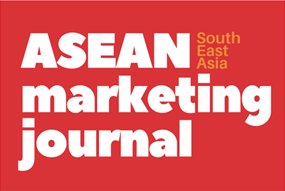
Abstract
Manuscript type: Empirical paper
Research Aims: This paper aims to identify the topics of social media posts (on Twitter) from local skincare brands in Indonesia.
Design/methodology/approach: This descriptive study applied text analysis methods, specifically frequency analysis and topic modeling with the Latent Dirichlet Allocation (LDA) method. Data were collected from the top four skincare brands with over 10,000 followers using Twitter Academic API interfaced through the Twarc package in Python. The dataset contained 1290 tweets from Wardah, 17,491 tweets from Avoskin, 1,968 tweets from Somethinc, and 590 tweets from Whitelab. The data analysis used quanteda and topicmodels packages from R software.
Research findings: The findings revealed that the brands’ tweets can be categorised into 8-10 topics, which can be distilled further into three significant functions proposed by Saxton and Waters (2014): information, promotion and mobilisation, and community building and dialogue.
Theoretical Contribution/Originality: This study adds to the body of knowledge regarding social media marketing by adding insights into how local Indonesian brands carry out their social media marketing efforts.
Practitioner/Policy Implication: The findings implied that marketing managers should emphasise providing timely and relevant information as a base that can be used to build dialogic communication efforts with their audience.
Research limitation/Implications: This study only looked at four brands in the local skincare product category. In addition, this study applied automated topic modeling with LDA, which needed an a priori number of topics, which might affect the topic labelling. Furthermore, this study’s scope was limited to categorising the brand posts without examining the effects of brand post types on engagement metrics. Future studies can examine more samples by observing other product categories, applying thematic analysis to code each tweet, and comparing the results to topic modeling results. Lastly, future studies can examine the relationship between brand post types/categories and engagement metrics such as likes, comments, and retweets.
Keywords: Cosmetics Brands, Social Media Marketing, Skincare, Topic Modeling, Twitter
References
References
Ashley, C., & Tuten, T. (2015). Creative strategies in social media marketing: An exploratory study of branded social content and consumer engagement. Psychology and Marketing, 32, 15–27.
Chen, Y., Xie, J. (2008). Online consumer review: word-of-mouth as a new element of marketing communication mix. Manag. Sci. 54 (3), 477–491.
Cho, H., Kim, S., Lee, J., Lee, J.-S. (2014). Data-driven integration of multiple sentiment dictionaries for lexicon-based sentiment classification of product reviews. Knowl-Based Syst. 71, 61–71.
Dwivedi, Y. et al. (2021). Setting the future of digital and social media marketing research: Perspectives and research propositions. International Journal of Information Management 59, 102168.
Felix, R., Rauschnabel, P.A., Hinsch, C. (2017). Elements of strategic social media marketing: a holistic framework. J. Bus. Res. 70, 118–126.
Ghazali, E., Soon, P.C., Mutum, D.S., Nguyen, B. (2017). Health and cosmetics: investigating consumers’ values for buying organic personal care products. J. Retailing Consum. Serv. 39, 154–163.
Ibrahim, N.F., Wang, X., Bourne, H. (2017). Exploring the effect of user engagement in online brand communities: Evidence from Twitter. Computers in Human Behavior, 72, 321e338.
Kambatla, K., Kollias, G., Kumar, V., & Grama, A. (2014). Trends in big data analytics. Journal of Parallel and Distributed Computing, 74(7), 2561–2573.
Klaschka, U. (2016). Are natural compounds used in personal care products toxic for the aquatic environment? Sustainable Chemistry and Pharmacy 4, 13–20.
Lipsman, A., Mudd, G., Rich, M., & Bruich, S. (2012). The Power of “Like”. Journal of Advertising Research, 52, 40–52.
Madani, A., Boussaid, O., & Zegour, D. E. (2015). Real-time trending topics detection and description from Twitter content. Social Network Analysis and Mining, 5(1), 1e13.
Nagy, J., & Midha, A. (2014). The value of earned audiences: How social interactions amplify TV impact. Journal of Advertising Research, 54(4), 448e453.
Pang, B., & Lee, L. (2008). Opinion mining and sentiment analysis. Foundations and Trends® in Information Retrieval, 2(2), 1e135.
Sanz-Blas, S., Buzova, D., P ́erez-Ruiz, P. (2021). Building relational worth in an online social community through virtual structural embeddedness and relational embeddedness. Technol. Forecast. Soc. Chang. 162, 120350.
Sharda, Ramesh, Dursun Delen, Efraim Turban. (2018). Business Intelligence, Analytics, and Data Science: A Managerial Perspective. New York: Pearson.
Statista. (2022). Revenue of the skin care market in Indonesia from 2017 to 2026. Diakses pada 1 Juli 2022. https://www.statista.com/forecasts/1214255/indonesia-revenue-skin-care-market
Tafesse, W., Wien, A. (2017). A framework for categorizing social media posts. ISSN: (Print) 2331-1975.
Van Doorn, J., Lemon, K. N., Mittal, V., Nass, S., Pick, D., Pirner, P., & Verhoef, P. C. (2010). Customer engagement behavior: Theoretical foundations and research di- rections. Journal of Service Research, 13(3), 253–266.
Zollo, L., Filieri, R., Rialti, R., Yoon, S. (2020). Unpacking the relationship between social media marketing and brand equity: The mediating role of consumers’ benefits and experience. Journal of Business Research117, 256–267.
Recommended Citation
Lestari, Annisafira L. and Hananto, Arga
(2023)
"How Do Firms Use Social Media: Topic Modeling of Twitter Brand Posts of Four Indonesian Skincare Brands,"
ASEAN Marketing Journal: Vol. 15:
No.
2, Article 2.
DOI: https://doi.org/10.7454/amj.v15i2.1168
Available at:
https://scholarhub.ui.ac.id/amj/vol15/iss2/2





